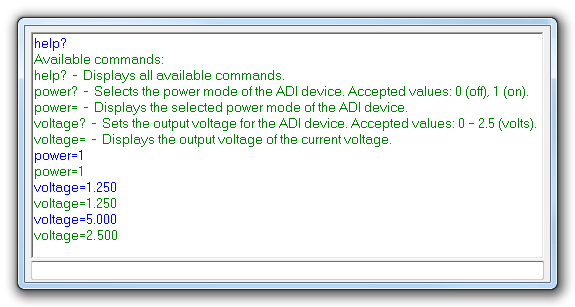 This version (01 Oct 2012 16:11) was approved by Dragos Bogdan.
This version (01 Oct 2012 16:11) was approved by Dragos Bogdan.This is an old revision of the document!
The ADP5589 is a 19 channel GPIO (General Purpose Input/Output) port expander with built-in keypad matrix decoder, programmable logic, reset logic, and PWM generator. The IC is capable of handling QWERTY size keyboards and GPIO expansion. I/O expander ICs are used in portable devices (phones, remote controls, & cameras) and non-portable applications (healthcare, industrial & instrumentation). I/O expanders can be used to increase the number of I/Os available to a processor or to reduce the number of I/Os required through interface connectors for front panel designs.
The ADP5589 handles all key scanning and decoding and can flag the main processor via an interrupt line that new key events have occurred. GPI changes and logic changes can also be tracked as events via the FIFO, eliminating the need to monitor different registers for event changes. The ADP5589 is equipped with a FIFO to store up to 16 events. Events can be read back by the processor via an I2C-compatible interface.
The ADP5589 frees up the main processor from having to monitor the keypad, thereby reducing power consumption and/or increasing processor bandwidth for performing other functions. The programmable logic functions allow common logic requirements to be integrated as part of the GPIO expander, saving board area and cost. Reference software Linux driver is available.
The goal of this project (Microcontroller No-OS) is to be able to provide reference projects for lower end processors, which can't run Linux, or aren't running a specific operating system, to help those customers using microcontrollers with ADI parts. Here you can find a generic driver which can be used as a base for any microcontroller platform and also specific drivers for different microcontroller platforms.
The driver contains two parts:
The Communication Driver has a standard interface, so the ADP5589 driver can be used exactly as it is provided.
There are three functions which are called by the ADP5589 driver:
I2C driver architecture
The implementation of these three functions depends on the used microcontroller.
The following functions are implemented in this version of ADP5589 driver:
| Function | Description |
|---|---|
| void ADP5589_SetRegisterValue(unsigned char registerAddress, unsigned char registerValue) | Writes data into a register. |
| unsigned char ADP5589_GetRegisterValue(unsigned char registerAddress) | Reads the value of a register. |
| char ADP5589_Init(void) | Initializes the communication peripheral and checks if the ADP5589 part is present. |
| void ADP5589_InitPwm(void) | Initializes the PWM generator in continuous mode. |
| void ADP5589_SetPwm(unsigned short pwmOffTime, unsigned short pwmOnTime) | Sets the PWM On and Off times. |
| void ADP5589_GpioDirection(unsigned char reg, unsigned char val) | Sets the direction of the pins. |
| unsigned char ADP5589_GetPinState(unsigned char reg) | Reads the state of the pins. |
| void ADP5589_SetPinState(unsigned char reg, unsigned char state) | Sets the state of the pins. |
| void ADP5589_InitKey(unsigned char pmodPort) | Initializes keyboard decoder. |
| unsigned char ADP5589_KeyDecode(unsigned char reg, unsigned char eventType, unsigned char pmodPort) | Decodes the key pressed on the Pmod-KYPD. |
| void ADP5589_KeyLock(unsigned char firstEvent, unsigned char secondEvent, unsigned char pmodPort) | Locks the ADP5589 and requests Password for unlock. |
HW Platform(s):
This section contains a description of the steps required to run the ADP5589 demonstration project on a Digilent Cerebot MX3cK platform.
Following commands were implemented in this version of ADP5589 reference project for Cerebot MX3cK board.
| Command | Description |
|---|---|
| help? | Displays all available commands. |
| pwmOnTime= | On time of the PWM pulse. Accepted values: 0 - 65535 |
| pwmOffTime= | Off time of the PWM pulse. Accepted values: 0 - 65535 |
| lastKey? | Displays the last key which was pressed |
Commands can be executed using a serial terminal connected to the UART1 peripheral of PIC32MX320F128H.
The following image shows a list of commands in a serial terminal connected to processor’s UART peripheral.

This section presents the steps for developing a software application that will run on the Digilent Cerebot MX3cK development board for controlling and monitoring the operation of the ADI part.
This section contains a description of the steps required to run the ADP5589 demonstration project on a Digilent Cerebot MC7 platform.
Following commands were implemented in this version of ADP5589 reference project for Cerebot MC7 board.
| Command | Description |
|---|---|
| help? | Displays all available commands. |
| pwmOnTime= | On time of the PWM pulse. Accepted values: 0 - 65535 |
| pwmOffTime= | Off time of the PWM pulse. Accepted values: 0 - 65535 |
| lastKey? | Displays the last key which was pressed |
Commands can be executed using a serial terminal connected to the UART1 peripheral of dsPIC33FJ128MC706A.
The following image shows a list of commands in a serial terminal connected to processor’s UART peripheral.

This section presents the steps for developing a software application that will run on the Digilent Cerebot MC7 development board for controlling and monitoring the operation of the ADI part.